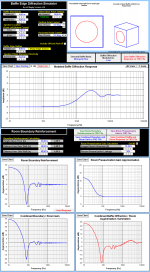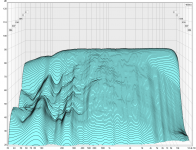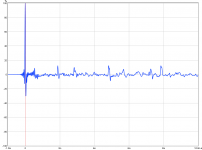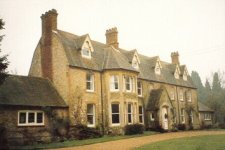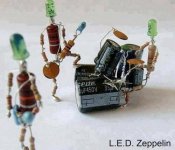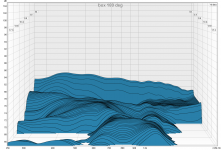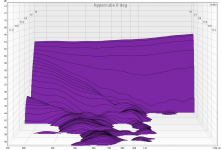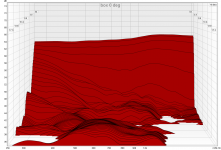gmad,
Very interesting though probably need to read #436 a couple times more it's complicated stuff and new for me but sounds very clever your solution. The non oversampling dacs i've seen are either quite old or very expensive ones. Strikes me you upsample to 176,2kHz most seems just upsample to 96 or 192kHz, guess you have it as i that something in sound is more right the even way. Alike the slight drop in high frequencies (minimizing the ringing) you talk about is discussed very much in this thread http://www.diyaudio.com/forums/lounge/249418-dac-filtering-rasmussen-effect-54.html#post4214471. A thought though very undocumented is in the area of slight dampening and drop in higher frequency area don't hurt is that most PSU and amp stages thru chain have lots of smaller good quality local storage and decouling capitors, meaning lower z and faster firering conditions for HF transients than for LF ones, maybe therefor it's good to damp the HF speed somewhere.
Myself run a probably seen by many outdated AKM4393 and pretty shure it say something as 128x oversampling and have analog domain switched-capasitor-filter, it's housed in a Behringer DEQ2496 i feed by light for isolation and modification wise have only upgraded the cheap capasitors inside especially the electrolytic ones and made the last stage to be DC coupled single ended with low offset. Have tried faster opamps ex LM49710 but prefer the build in RC4580 ones.
If at a time you will try the speaker linearizing networks here is a great program to tune the network and get out exact component values http://www.diyaudio.com/forums/multi-way/259865-xsim-free-crossover-designer.html. It's free and meant for XO but I found it great helper to find values, before did discover that program i made rough calgulation and sat exchanging values and made tens of measurement to hit as best as possible components, in that program pick a amp and a driver and attach a dot zma file to the driver and you ready to find precise component values by sweeping the component value up/down tailored for that particular box/driver combination.
The LF dip talked about could be the three boundary distances bag wall side wall and floor nearly same. Did a plot attached in a J. Bagsby tool with estimated distances and got a suchout spike at -25dB. Tool found here here software.
Thanks for all the technical hints for DRC gmad and wesayso. The IR #437 at listening position is a big whau.
xrk971 thanks clarify the material, stupid me order expensive sheets from NL and just need go to the kitchen to find the stuff http://www.diyaudio.com/forums/full-range/268037-fast-tl-8.html#post4192688.
Very interesting though probably need to read #436 a couple times more it's complicated stuff and new for me but sounds very clever your solution. The non oversampling dacs i've seen are either quite old or very expensive ones. Strikes me you upsample to 176,2kHz most seems just upsample to 96 or 192kHz, guess you have it as i that something in sound is more right the even way. Alike the slight drop in high frequencies (minimizing the ringing) you talk about is discussed very much in this thread http://www.diyaudio.com/forums/lounge/249418-dac-filtering-rasmussen-effect-54.html#post4214471. A thought though very undocumented is in the area of slight dampening and drop in higher frequency area don't hurt is that most PSU and amp stages thru chain have lots of smaller good quality local storage and decouling capitors, meaning lower z and faster firering conditions for HF transients than for LF ones, maybe therefor it's good to damp the HF speed somewhere.
Myself run a probably seen by many outdated AKM4393 and pretty shure it say something as 128x oversampling and have analog domain switched-capasitor-filter, it's housed in a Behringer DEQ2496 i feed by light for isolation and modification wise have only upgraded the cheap capasitors inside especially the electrolytic ones and made the last stage to be DC coupled single ended with low offset. Have tried faster opamps ex LM49710 but prefer the build in RC4580 ones.
If at a time you will try the speaker linearizing networks here is a great program to tune the network and get out exact component values http://www.diyaudio.com/forums/multi-way/259865-xsim-free-crossover-designer.html. It's free and meant for XO but I found it great helper to find values, before did discover that program i made rough calgulation and sat exchanging values and made tens of measurement to hit as best as possible components, in that program pick a amp and a driver and attach a dot zma file to the driver and you ready to find precise component values by sweeping the component value up/down tailored for that particular box/driver combination.
The LF dip talked about could be the three boundary distances bag wall side wall and floor nearly same. Did a plot attached in a J. Bagsby tool with estimated distances and got a suchout spike at -25dB. Tool found here here software.
Thanks for all the technical hints for DRC gmad and wesayso. The IR #437 at listening position is a big whau.
xrk971 thanks clarify the material, stupid me order expensive sheets from NL and just need go to the kitchen to find the stuff http://www.diyaudio.com/forums/full-range/268037-fast-tl-8.html#post4192688.
Attachments
Last edited:
xrk971 thanks clarify the material, stupid me order expensive sheets from NL and just need go to the kitchen to find the stuff FAST with TL?.
Those sheets will come in handy to place behind the driver inside the box to prevent the back reflection onto the cone. Not wasted so don't worry. You will use it.
Thanks BYRTT. The side/front wall distance is more like 37" and the height is about 28". The room is almost 11' wide (maybe the source of the dip) and not at all airtight.
I got some good results by tweaking DRC a bit and I'll be able to share more later on. In the future I may experiment with a different speaker/sofa placement as well.
I got some good results by tweaking DRC a bit and I'll be able to share more later on. In the future I may experiment with a different speaker/sofa placement as well.
Attached are the results of my attempt to deal with the dip. Why I put so much effort into fixing something that wasn't really bothering me in the first place is probably a question we all ask ourselves from time to time 😉.
In order to (almost) eliminate the dip I needed to tell DRC to correct the signal over a bigger amplitude and frequency range as well as over a longer time period. Then, in order to prevent DRC from making my tiny speakers flat down to 32hz, I applied a Linkwitz transform type eq curve to my measured impulse response (before feeding it to DRC). The results (attached) are pretty good with excellent sound from the sweet-spot, but worse sound from elsewhere in the room. I have since reverted back to correcting over a shorter time period so what I'm listening to now is not quite as good as the attached waterfall, but sounds good all over the room and is an improvement (at least I think so right now) over what I posted previously.
In order to (almost) eliminate the dip I needed to tell DRC to correct the signal over a bigger amplitude and frequency range as well as over a longer time period. Then, in order to prevent DRC from making my tiny speakers flat down to 32hz, I applied a Linkwitz transform type eq curve to my measured impulse response (before feeding it to DRC). The results (attached) are pretty good with excellent sound from the sweet-spot, but worse sound from elsewhere in the room. I have since reverted back to correcting over a shorter time period so what I'm listening to now is not quite as good as the attached waterfall, but sounds good all over the room and is an improvement (at least I think so right now) over what I posted previously.
Attachments
update
In my following post I will provide a "virtual audition" of the Hypercubes in my room, but first, a quick update. I have experimented with the use of adhesive vinyl damping sheets on the interior surfaces of the enclosures. The subjective and objective results are very similar to what I observed using foam stuffing; the sound (from close up) is slightly more "closed in" but also slightly "cleaner" and there is no more ringing at 1.5k. I'm not sure that I can hear the reduction in "openness" from several feet away where I listen from, but I think the slightly "cleaner" nature holds up on things like unaccompanied choral recordings. I think it's cool that the signature of the speakers can be fine tuned without worry of a bad result.
edit: I am trying to upload the clips right now but am getting an error message about a missing security token...
In my following post I will provide a "virtual audition" of the Hypercubes in my room, but first, a quick update. I have experimented with the use of adhesive vinyl damping sheets on the interior surfaces of the enclosures. The subjective and objective results are very similar to what I observed using foam stuffing; the sound (from close up) is slightly more "closed in" but also slightly "cleaner" and there is no more ringing at 1.5k. I'm not sure that I can hear the reduction in "openness" from several feet away where I listen from, but I think the slightly "cleaner" nature holds up on things like unaccompanied choral recordings. I think it's cool that the signature of the speakers can be fine tuned without worry of a bad result.
edit: I am trying to upload the clips right now but am getting an error message about a missing security token...
Last edited:
virtual audition
The attached sound clips will serve as a "virtual audition" of the Hypercube speakers as "heard" from the listening position of my room. They are the result of convolving music clips with the impulse responses of the system as measured from the listening spot (left channel of the clip convolved with the left speaker IR etc...). The impulse response has had a small amount of correction applied to it using DRC with a windowing size of 200ms @ 20hz - .2ms @ 20khz which is the correction strength I have been using while listening for a little while now. Anyone who has attempted to record and listen to the sound from their speakers (or any sound for that matter) already knows that in real life the room is not noticed as much as it is in the recording. Headphone use is recommended and crossfeed could be applied additionally for more realism.
Special thanks to a rockin' friend in the Netherlands for helping with the hosting. Clip no. 8 is for you 😉.
http://www.rsr-concepts.com/diyma/hypercubes convolved mp3.zip
The attached sound clips will serve as a "virtual audition" of the Hypercube speakers as "heard" from the listening position of my room. They are the result of convolving music clips with the impulse responses of the system as measured from the listening spot (left channel of the clip convolved with the left speaker IR etc...). The impulse response has had a small amount of correction applied to it using DRC with a windowing size of 200ms @ 20hz - .2ms @ 20khz which is the correction strength I have been using while listening for a little while now. Anyone who has attempted to record and listen to the sound from their speakers (or any sound for that matter) already knows that in real life the room is not noticed as much as it is in the recording. Headphone use is recommended and crossfeed could be applied additionally for more realism.
Special thanks to a rockin' friend in the Netherlands for helping with the hosting. Clip no. 8 is for you 😉.
http://www.rsr-concepts.com/diyma/hypercubes convolved mp3.zip
The concept of the virtual audition via DRC processed source convolved with speaker and room signature in the impulse function at listening position is really a cool new age for diyAudio. Yes, it lacks the effects of non linear driver distortion, power compression, etc. but I think to first order it is a very close representation to what the listener at the measured position hears. You must use headphones to receive the virtual audition though.
Thanks for taking the time to do this and for sharing.
Thanks for taking the time to do this and for sharing.
Thanks, X. Personally, I don't feel that the lack of nonlinear distortion with this type of demo is a big deal since it's not something I notice at my normal listening volume anyway. I do appreciate however the excellent signal to noise ratio that this method makes possible.
Wow 8 tracks thanks all that work.
I'm surprised how true in room at listening position frequency response sounds to be a copy of reference track. Track 1 i have the original CD and can compare and this is amasing, same goes for wesayso lines where i had a reference too. When listening i like same time to look at picture of your living room at #232 then it's nearly as being in NY .
At present i haven't got a good enough basis speaker im satisfied with, as soon this happen will like to try your and wesayso's magic.
Perceived you play guitar yourself seen at another thread wonder is it gmad playing track 5 and 6 🙂.
EDIT The hard edge we talked about at wesayso's thread seems not a signature here this is softer edge, could it be because of 25 driver firing instead of one and that the 25 drivers haven't same timing distance to microphone.
I'm surprised how true in room at listening position frequency response sounds to be a copy of reference track. Track 1 i have the original CD and can compare and this is amasing, same goes for wesayso lines where i had a reference too. When listening i like same time to look at picture of your living room at #232 then it's nearly as being in NY .
At present i haven't got a good enough basis speaker im satisfied with, as soon this happen will like to try your and wesayso's magic.
Perceived you play guitar yourself seen at another thread wonder is it gmad playing track 5 and 6 🙂.
EDIT The hard edge we talked about at wesayso's thread seems not a signature here this is softer edge, could it be because of 25 driver firing instead of one and that the 25 drivers haven't same timing distance to microphone.
Last edited:
Thanks, BYRTT. The sound really is quite neutral. I have compared dual mono white noise on my Sennheiser HD6## headphones to the sound of the speakers from the sweet spot. The white noise doesn't sound so good for a virtual audition though (it really highlights how much the room sound is "glued" into the recording).
I was hoping you would do the audition the right way by looking at the room picture! But, to really be here, you must have one of these:
I actually did consider making my own clips (guitar). Maybe next time...
I was hoping you would do the audition the right way by looking at the room picture! But, to really be here, you must have one of these:

I actually did consider making my own clips (guitar). Maybe next time...
I'm very impressed with these tracks! Not only does it measure well, it sound really good too? Wonder if there's a connection there 😉.
All kidding aside I loved the listening experience. I even played track 8 on my lines, immediately followed by the original HD track of coarse! Much easier on the ears than hearing the doubling of my own room effects (to play my own virtual demo on my own speakers) to be honest. Have you even tried that? Took me a while to get back to normal listening after that 😀.
All kidding aside I loved the listening experience. I even played track 8 on my lines, immediately followed by the original HD track of coarse! Much easier on the ears than hearing the doubling of my own room effects (to play my own virtual demo on my own speakers) to be honest. Have you even tried that? Took me a while to get back to normal listening after that 😀.
The attached sound clips will serve as a "virtual audition" of the Hypercube speakers as "heard" from the listening position of my room. They are the result of convolving music clips with the impulse responses of the system as measured from the listening spot (left channel of the clip convolved with the left speaker IR etc...). The impulse response has had a small amount of correction applied to it using DRC with a windowing size of 200ms @ 20hz - .2ms @ 20khz which is the correction strength I have been using while listening for a little while now. Anyone who has attempted to record and listen to the sound from their speakers (or any sound for that matter) already knows that in real life the room is not noticed as much as it is in the recording. Headphone use is recommended and crossfeed could be applied additionally for more realism.
Special thanks to a rockin' friend in the Netherlands for helping with the hosting. Clip no. 8 is for you 😉.
http://www.rsr-concepts.com/diyma/hypercubes convolved mp3.zip
Gmad,
These all sound excellent! Nicely done. The tracks have unbelievably good dynamics and percussive quickness - especially on the acoustic guitar. The bass is really quite remarkable. In reality, does your RS100-4 in a Hypercube achieve this level of bass richness? If so, that is just amazing - don't need a subwoofer or even a bass driver. I assume listening position is near field circa 1m away? I have a whole new respect for the RS100-4 and what DRC can do. It is like listening to the original source! Wow.

Wesayso, LZ's Houses of the Holy may just be my new favorite song! Haven't heard it in a while but here, just really nice.
Lot's of cool tracks available in the Led Zeppelin catalog if you ask me. I love it how you hear the foot pedal of the drums squeak on Since I've Been Loving You. Lot's of primitive experiments on their recordings, recording were it sounds the best for the song for example a big hall to record the drums for When The Levee Breaks etc.

(This was the building, Headley Grange)
A rare Plant outside 😉:
Cool story: http://www.philsbook.com/rolling-mobile-3.htm
(This was the building, Headley Grange)
An externally hosted image should be here but it was not working when we last tested it.
A rare Plant outside 😉:
An externally hosted image should be here but it was not working when we last tested it.
Cool story: http://www.philsbook.com/rolling-mobile-3.htm
Attachments
Last edited:
wesayso, Thanks. Yes, as we know there's a connection, and as we also know, it takes a little time to learn what to measure, how to measure it (fairly) accurately and how to meaningfully interpret the measurements. So, by the time we're deaf, we should be experts! 😀
And no, since I noticed that I was indeed more aware of my room's sound after listening virtually with headphones, I've been too scared to hear the effect doubled! But as you said, the hearing normalizes again after a little while.
BYRTT, you're welcome back anytime. 😀
X, Thanks for the kind words. Yes, it really does sound like that. I think the very inert acrylic hypercube makes for some clean bass. I'm letting the bass roll off below 64hz and it's a good compromise for me between extension and headroom (and luckily, my room seems to provide a little lift in the bottom octave). The positioning is a 5' equi triangle with speakers just over 3' from the back and side walls. Eventually, I'll learn how to do SPL calibration to get some meaningful HD measurements...
Guys, this is a lot of fun and thanks again for the feedback.
And no, since I noticed that I was indeed more aware of my room's sound after listening virtually with headphones, I've been too scared to hear the effect doubled! But as you said, the hearing normalizes again after a little while.
BYRTT, you're welcome back anytime. 😀
X, Thanks for the kind words. Yes, it really does sound like that. I think the very inert acrylic hypercube makes for some clean bass. I'm letting the bass roll off below 64hz and it's a good compromise for me between extension and headroom (and luckily, my room seems to provide a little lift in the bottom octave). The positioning is a 5' equi triangle with speakers just over 3' from the back and side walls. Eventually, I'll learn how to do SPL calibration to get some meaningful HD measurements...
Guys, this is a lot of fun and thanks again for the feedback.
Last edited:
Correction
I noticed while browsing through my speaker measurement files that there was a problem with the rear (180 deg) hypercube measurement file used in post 302. REW was not displaying the files properly because there was too long of a "silence" period before the spike (I didn't use REW for the measurement). I used the silence truncation effect in Audacity to remove the excess, but for whatever reason the hypercube file got cut too short after the spike leading to a gating type effect. The hypercube enclosure allows a faster decay than the box but the difference at the rear of the enclosures is not as extreme as the previous measurement implied.
I have attached new waterfall plots here. I attached 0 degree plots as well even though similar ones have already been shown. These are all using the original raw files; they are not made from new measurements.
The box is made from 1/2" thick plywood and has 3/4" adhesive foam attached to the interior surfaces. The dimensions progress 1, 1.272, 1.618. The hypercube is made from 1/4" acrylic and has some loose-fitting open cell foam inside. I tried to give the advantage to the box.
edit: note that the freq range of these plots is only 3 octaves...
I noticed while browsing through my speaker measurement files that there was a problem with the rear (180 deg) hypercube measurement file used in post 302. REW was not displaying the files properly because there was too long of a "silence" period before the spike (I didn't use REW for the measurement). I used the silence truncation effect in Audacity to remove the excess, but for whatever reason the hypercube file got cut too short after the spike leading to a gating type effect. The hypercube enclosure allows a faster decay than the box but the difference at the rear of the enclosures is not as extreme as the previous measurement implied.
I have attached new waterfall plots here. I attached 0 degree plots as well even though similar ones have already been shown. These are all using the original raw files; they are not made from new measurements.
The box is made from 1/2" thick plywood and has 3/4" adhesive foam attached to the interior surfaces. The dimensions progress 1, 1.272, 1.618. The hypercube is made from 1/4" acrylic and has some loose-fitting open cell foam inside. I tried to give the advantage to the box.
edit: note that the freq range of these plots is only 3 octaves...
Attachments
Last edited:
My hats off to you. DRC Magic being witnessed here. Never have I seen a waterfall plot that looks like a glistening laminar flow waterfall down a straight wall! Wow!!!


My hats off to you. DRC Magic being witnessed here. Never have I seen a waterfall plot that looks like a glistening laminar flow waterfall down a straight wall! Wow!!!

Well, these are not using DRC, just smoothing. However, with the help of DRC, the resulting waterfall does match your description 😉. I don't think I have shown that before though....
Last edited:
- Status
- Not open for further replies.
- Home
- Loudspeakers
- Full Range
- Hypercube Loudspeakers
